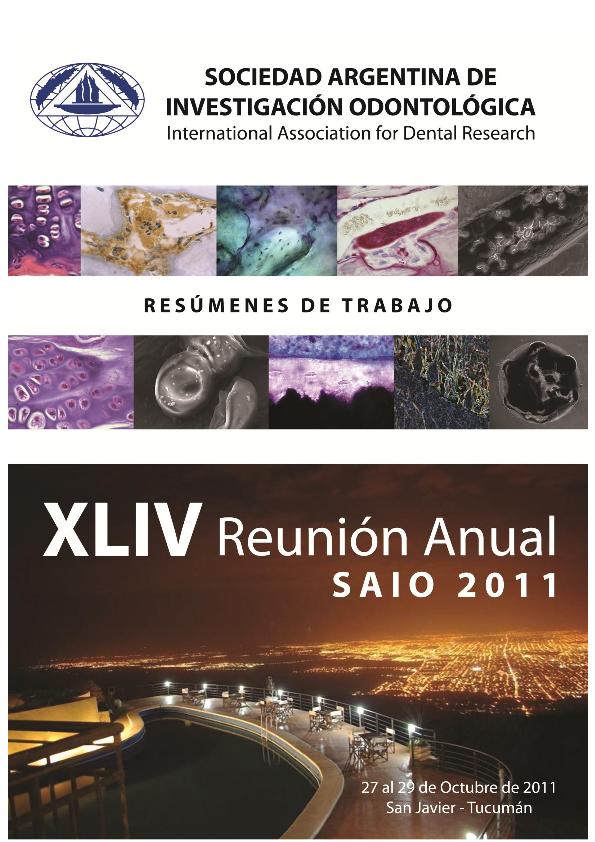Evento
Comparación in vitro de filtración marginal entre ionómeros vítreos como selladores de fisura
Tipo del evento:
Reunión
Nombre del evento:
XLIV Reunión Anual de la Sociedad Argentina de Investigación Odontológica
Fecha del evento:
27/10/2011
Institución Organizadora:
Sociedad Argentina de Investigación Odontológica;
Título del Libro:
XLIV Reunión Anual de la Sociedad Argentina de Investigación Odontológica
Editorial:
Sociedad Argentina de Investigación Odontológica
Idioma:
Inglés
Clasificación temática:
Resumen
The aim of this study was evaluate in vitro the marginal microleakage of two glass ionomer materials used as pit-and-fissure sealants. Thirty healthy premolars, extracted for orthodontic treatment were randomly assigned in to II groups (n=15) and sealant by two glass ionomer (Group I: Fuji VII and Group II: Fuji IX). All teeth conserved in artificial saliva (NAF) for 10 days, were thermocycled (250 cycles; 5ºC, 37ºC and 60ºC), isolated, immersed in 2% alcohol solution gentian violet blue dye for 4 h. After washed, they were included in acrylic resin and sectioned longitudinally in buccolingual direction by cutting device (Miniton de Struers). Samples were analyzed for leakage using light microscope (Olympus BX-60M). A semi-quantitative ranked scale from Williams & Winter was used to score dye penetration. Results: Group I was distributed as follows Grade 1: 1 and Grade 3: 14 (Mean 2.87 Median 3, SD 0.52). Group II was distributed: Grade 0: 4, Grade 1: 3 Grade 2: 2 and Grade 3: 6. (Mean 1.67, Median 2, SD 1.29). Fisher Exact Test showed statistically significant differences between materials (p = 0.006). From these results, we concluded that Fuji IX showed better marginal seal than Fuji VII, when used as pit- fissure sealant. The aim of this study was evaluate in vitro the marginal microleakage of two glass ionomer materials used as pit-and-fissure sealants. Thirty healthy premolars, extracted for orthodontic treatment were randomly assigned in to II groups (n=15) and sealant by two glass ionomer (Group I: Fuji VII and Group II: Fuji IX). All teeth conserved in artificial saliva (NAF) for 10 days, were thermocycled (250 cycles; 5ºC, 37ºC and 60ºC), isolated, immersed in 2% alcohol solution gentian violet blue dye for 4 h. After washed, they were included in acrylic resin and sectioned longitudinally in buccolingual direction by cutting device (Miniton de Struers). Samples were analyzed for leakage using light microscope (Olympus BX-60M). A semi-quantitative ranked scale from Williams & Winter was used to score dye penetration. Results: Group I was distributed as follows Grade 1: 1 and Grade 3: 14 (Mean 2.87 Median 3, SD 0.52). Group II was distributed: Grade 0: 4, Grade 1: 3 Grade 2: 2 and Grade 3: 6. (Mean 1.67, Median 2, SD 1.29). Fisher Exact Test showed statistically significant differences between materials (p = 0.006). From these results, we concluded that Fuji IX showed better marginal seal than Fuji VII, when used as pit- fissure sealant. The aim of this study was evaluate in vitro the marginal microleakage of two glass ionomer materials used as pit-and-fissure sealants. Thirty healthy premolars, extracted for orthodontic treatment were randomly assigned in to II groups (n=15) and sealant by two glass ionomer (Group I: Fuji VII and Group II: Fuji IX). All teeth conserved in artificial saliva (NAF) for 10 days, were thermocycled (250 cycles; 5ºC, 37ºC and 60ºC), isolated, immersed in 2% alcohol solution gentian violet blue dye for 4 h. After washed, they were included in acrylic resin and sectioned longitudinally in buccolingual direction by cutting device (Miniton de Struers). Samples were analyzed for leakage using light microscope (Olympus BX-60M). A semi-quantitative ranked scale from Williams & Winter was used to score dye penetration. Results: Group I was distributed as follows Grade 1: 1 and Grade 3: 14 (Mean 2.87 Median 3, SD 0.52). Group II was distributed: Grade 0: 4, Grade 1: 3 Grade 2: 2 and Grade 3: 6. (Mean 1.67, Median 2, SD 1.29). Fisher Exact Test showed statistically significant differences between materials (p = 0.006). From these results, we concluded that Fuji IX showed better marginal seal than Fuji VII, when used as pit- fissure sealant.
Palabras clave:
glass ionomer
,
fissure sealants
,
microleakage
Archivos asociados
Licencia
Identificadores
Colecciones
Eventos(PROIMI)
Eventos de PLANTA PILOTO DE PROC.IND.MICROBIOLOGICOS (I)
Eventos de PLANTA PILOTO DE PROC.IND.MICROBIOLOGICOS (I)
Citación
Comparación in vitro de filtración marginal entre ionómeros vítreos como selladores de fisura; XLIV Reunión Anual de la Sociedad Argentina de Investigación Odontológica; Tucumán; Argentina; 2011; 1-2
Compartir




